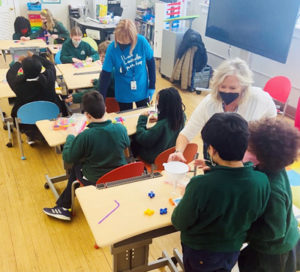 Fifth grader Aaron Simpson knew it was going to be a different kind of science lesson when he whizzed by his classmates on a chair with wheels. Louisville Water educator Laura Keeling was demonstrating one of the forces that move water: a push.
Fifth grader Aaron Simpson knew it was going to be a different kind of science lesson when he whizzed by his classmates on a chair with wheels. Louisville Water educator Laura Keeling was demonstrating one of the forces that move water: a push.
Keeling, a retired Jefferson County Public Schools STEM (Science, Technology, Engineering, and Math) teacher, worked with another Louisville Water educator, Susan Sampson (also retired from JCPS), to adapt the lesson for students at the Holy Trinity Parish School Clifton Campus.
Between the two educators, they have more than 75 years in the classroom. That experience came in handy when working with the bright, inquisitive Holy Trinity students who were learning the same things as their peers, just in a different way.
The Holy Trinity satellite campus is open to all students and uses the Orton-Gillingham approach to learning. Students are engaged using methods that stimulate more of their senses but in a very structured environment.
“We wanted to make sure that these students had the very same learning opportunity that other students have when we teach this lesson,”’ said Sampson. “The information was the same. We just adapted the delivery method.”
She used lots of pictures of water tanks and fire hydrants. Her kit even included a real piece of copper pipe for the students to touch and see.
This was Louisville Water’s fourth visit to Holy Trinity, and science teacher Tory Graham said it was the kind of hands-on learning that her students need.
“Since Covid, field trips have been limited, and having outside educators visit our classroom gives students some variety,” Graham said. “This is our fourth water company lesson, and we’ve gotten really positive feedback from the students and parents.”
The Force and Motion lesson, popular with students and teachers throughout the region, uses things like straws, funnels, and string to demonstrate how water is moved throughout the community. Students build a water delivery system using plastic toy pipes and are challenged to move a small bead that simulates water movement through the structure.
“We try hard to engage the students’ senses,” said Keeling. “The students stand up and push and pull with their hands. They create circles with their arms raised above their heads to visually show how large water mains can be.”
The two seasoned classroom veterans pointed out that the tweaked lesson also would work well with ESL (English as a Second Language) students because it’s heavy on visuals. Louisville Water Manager of Outreach and Education Channa Newman said, “Our message about water and health is universal, and we do everything we can to effectively get that information out to our customers. Educators like Susan and Laura are valuable parts of our communication team and help ensure that our programs are inclusive.”
Louisville Water has been doing classroom programs since 2000. During a regular school year, the company’s educators reach more than 40,000 students. Visit the Louisville Water website to learn more about classroom and community programming.

